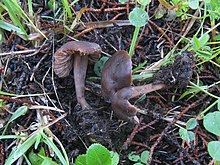Neohygrocybe ovina
| Blushing waxcap | |
|---|---|

| |
| Scientific classification | |
| Domain: | Eukaryota |
| Kingdom: | Fungi |
| Division: | Basidiomycota |
| Class: | Agaricomycetes |
| Order: | Agaricales |
| Family: | Hygrophoraceae |
| Genus: | Neohygrocybe |
| Species: | N. ovina
|
| Binomial name | |
| Neohygrocybe ovina (Bull.) Herink (1958)
| |
| Synonyms | |
Neohygrocybe ovina is a species of agaric (gilled mushroom) in the family Hygrophoraceae. It has been given the recommended English name of blushing waxcap,[2] since the lamellae (gills) and flesh turn pinkish red when bruised. The species has a European distribution, occurring mainly in agriculturally unimproved grassland. Threats to its habitat have resulted in the species being assessed as globally "vulnerable" on the IUCN Red List of Threatened Species.[1]
Taxonomy
The species was first described from France in 1793 by mycologist Jean Baptiste Bulliard as Agaricus ovinus. French mycologist Robert Kühner transferred it to the genus Hygrocybe in 1926.
Recent
Description
Distribution and habitat
The Blushing Waxcap is widespread but generally rare throughout Europe. A similar species, Neohygrocybe subovina, occurs in North America.[3] Like most other European waxcaps, Neohygrocybe ovina occurs in old, agriculturally unimproved, short-sward grassland (pastures and lawns).
Recent research suggests waxcaps are neither
Conservation
Neohygrocybe ovina is typical of
See also
References
- ^ a b c Mešić, A. "Hygrocybe ovina. The IUCN Red List of Threatened Species". Retrieved 2022-05-02.
- ^ Holden L. (July 2014). "English names for fungi 2014". British Mycological Society. Retrieved 2016-02-06.
- ^ S2CID 220615978.

- ISBN 978-87-983581-7-6.
- S2CID 318326.
- ^ a b c d e f "National red Lists". Retrieved 2022-05-02.
- ^ "Den danske rødliste: Neohygrocybe ovina". Retrieved 2022-05-02.
- ^ "Red List: Neohygrocybe ovina". Rote Liste Zentrum. Retrieved 2022-05-02.

